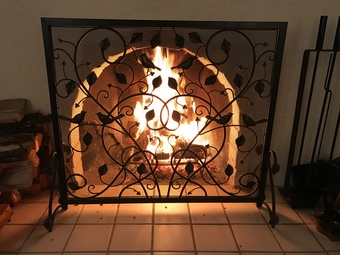Now that winter is here, it’s time to light a fire in your fireplace. A fireplace is a wonderful way to add warmth and charm to your home. Especially on cold and raining days. Here is a great article from HomeAdvisors about installing fireplaces.

Some types of fireplaces can even help reduce your heating bills each month. But before you start calling contractors, there are a number of practical and cost-related factors to consider.
Types of Fireplaces
The best fireplace for you may vary depending on a number of factors, including your home type, energy needs and design preferences. The three main types of fireplaces you’ll find are:
Wood-burning – A wood-burning fireplace uses logs as its main source of fuel. Purchasing firewood to burn on a regular basis can get expensive, but you won’t have to worry about installing a gas line or running up your electric bill. Wood-burning styles do require frequent cleaning and regular maintenance in order to operate safely and efficiently.
Gas – A gas fireplace uses natural gas to heat your home. You won’t have to purchase logs to fuel your fire, and there’s a lot less maintenance involved than what you’d have with a wood-burning option. Installing a gas line can be expensive, though, and using a gas fireplace can lead to a serious spike in monthly utility costs.
Electric – An electric fireplace is powered purely by electricity, making it one of the easiest to operate and maintain. All you have to do is flip a switch or push a button to start your fire. The drawback to an electric style is that wiring installation costs can be steep, and you’ll likely see an increase in your electricity bill.
Cost Considerations
In addition to the cost of materials, homeowners need to factor in how much professional installation will cost. Labor expenses for more complicated jobs are usually greater than the cost of the unit itself.
To install a wood-burning fireplace, the average homeowner can expect to pay between $860 and $3,500, according to HomeAdvisor’s True Cost Guide. The national average cost for gas fireplace installation is $2,160. The average cost to install an electric fireplace is usually between $150 and $300, but it can be significantly more if the electrical outlet or junction box is further away from the fireplace
Other common installation cost factors to keep in mind include:
Gas line installation – Even if you already have a gas line in your home, you may need to install an additional line that leads to your new gas fireplace. According to HomeAdvisor’s True Cost Guide, the average homeowner can expect to pay a minimum of $200 and then another $100 to install a propane tank. Connecting your house gas line to the street line or main supply can cost between $500 and $2,000.
Assembly & Customization – Most fireplace units require at least some assembly before the actual installation process can begin. This cost can vary greatly based on the complexity of the job and the level of customization needed. According to HomeAdvisor’s True Cost Guide, the average homeowner can expect to pay $600 for basic assembly and more for any customization.
Ventilation – The cost of installing ventilation is determined by the location of the vent system as well as local regulations. While a more basic installation could cost as little as $200, it can be significantly higher depending on the type of fireplace you choose.
Chimney Considerations
For many gas fireplaces and any wood-burning fireplace, you’ll need a properly functioning chimney. If your current chimney liner is cracked, deteriorating or not up to code, it will need to be replaced before any kind of installation can begin. According to HomeAdvisor’s True Cost Guide, the average cost to install a new chimney liner is $2,500.
From this point on chimney maintenance is mandatory. Routine chimney sweeps — and regular inspections by a professional — are essential to preventing deadly chimney fires as well as carbon monoxide poisoning.
For Homes Without Chimneys: A vented natural gas or propane fireplace can be installed just about anywhere. You’ll need to build a fireplace vent leading to the outside of your home, and just like a chimney, this flue will be need to be cleaned and maintained.
Another option that doesn’t require a home with a chimney is a ventless natural gas fireplace. These prefabricated fireplaces are typically cost-effective, but because they vent into the home rather than outside of it, improper installation or usage can lead to disastrous consequences, including carbon monoxide poisoning and even death.
An electric fireplace doesn’t produce any emissions, so ventilation won’t be an issue. These fireplaces are typically cost-effective and easy to maintain. Because new wiring is almost always needed, an electric fireplace should be installed by a license electrician. As with any electrical device, it should only be used in compliance with its operating instructions.
Thinking of making a move? Call or text me at 619.980.2738 and let’s start a conversation!
